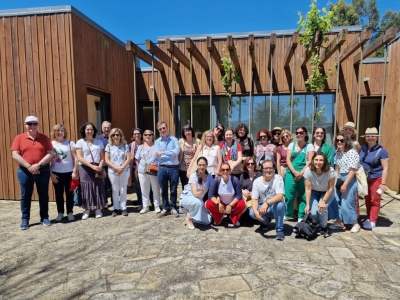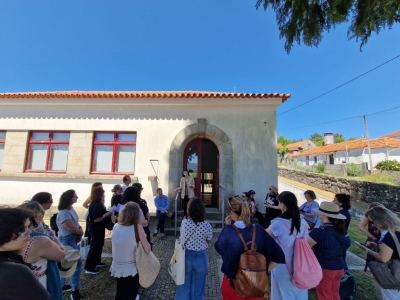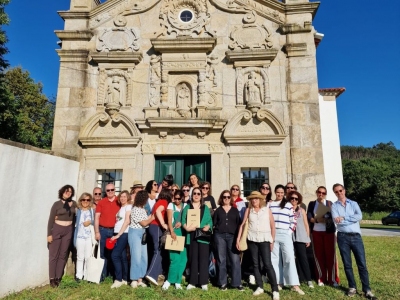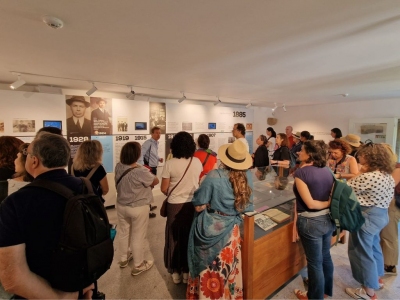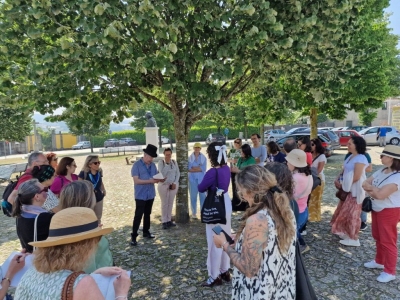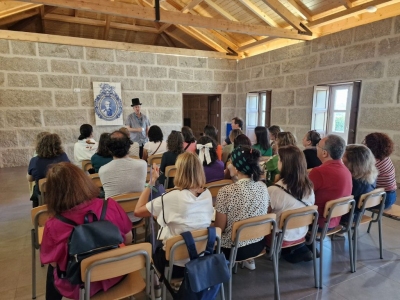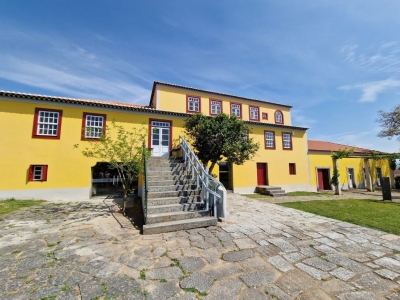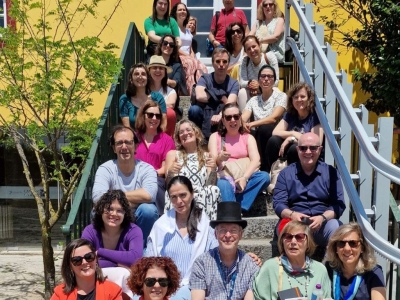Postgraduate students in Literary Tourism visit Alto Minho
As part of the Field Lab curricular unit of the postgraduate course in Literary Tourism at ESHTE, an immersion in the territories of Paredes de Coura and São Miguel de Seide (Famalicão) took place between May 23 and 25, 2025.
The study visit program began at the Municipal Archives of Paredes de Coura. The technician in charge, Dr. Fátima Cabodeira, was responsible for presenting the main activities developed in the context of the preservation of the municipal documentary heritage. Emphasis was placed on the one under her custody and which focuses on the collection of the writer Aquilino Ribeiro and the Dantas Machado family, and which has allowed the development of a set of exhibition and editorial activities that greatly strengthen the literary tourism strategy undertaken by the municipality of Paredes de Coura.
The second moment was the discovery of the Mário Cláudio Study Center, located in the rural parish of Venade. The graduates had the opportunity to discover an innovative cultural project that links literature and the surrounding area, based on cooperation methods that optimize the development of territorial cohesion and the establishment of alternative tourism development practices. Of particular relevance was the visit they made to its facilities, where they discovered the rooms where the valuable documentary collection of the author Mário Cláudio is located, the multipurpose room intended for cultural activities, and the annex building that has accommodated numerous researchers who come to this center to study the writer's work.
The third moment highlighted the project of the Casa Grande de Romarigães, which is based on the literary landscape created by Aquilino Ribeiro and which is supported by a set of activities that revolve around his narrative. Located in a markedly rural landscape, next to the state highway, the wealth of ancestral heritage spreads throughout the surrounding region and expands the critical mass of the project that is being developed. It tends to be read in the context of a dynamic that enhances the municipality of Paredes de Coura, its physical territory, and its local community, which is ultimately the main agent of this space and this framework.
Aware of these commitments, the trainees began by visiting the two-story building next to the chapel, with a square floor plan, which once housed a public school at the initiative of Councilor Miguel Dantas and was the subject of renovation under the auspices of the Municipal Council of Paredes de Coura and the writer's family. Thus, on the O floor, they learned more about the history of Aquilino Ribeiro, following a timeline and exploring the interactive display windows and screens, which, through approximate reality techniques, recreate the chronology of the Casa Grande de Romarigães and the development of its literary landscape.
The visit to the chapel dedicated to Our Lady of Amparo, where a short animated film was shown, which presents as its theme Aquilino's relationship with nature, as well as the visit to the stream, one of the scenic locations in the novel, allowed the trainees to take an active role in the plot sought, as in some unique tourist experiences. This immersive experience was further enriched by having attended a talk on the theme “Aquilino, the Citizen”, held on the 1st Floor of the renovated space of the Casa Grande de Romarigães, and a screening of the documentary “Aquilino, a Casa e o Sopro de Deus”, by João Pedro Marnoto, at the Municipal Cultural Center of Paredes de Coura. Ultimately, the study visit to the municipality of Paredes de Coura served for the trainees to note that some literary territories are suitable for building alternative tourist projects with strategic sustainability.
On the last day of the immersion, a visit was made to the Casa de Camilo, in S. Miguel de Seide, in a moment of great cultural enrichment, marked by knowledge, appreciation of historical memory and the celebration of Portuguese literature. The visit allowed direct contact with the life and work of Camilo Castelo Branco, through a tour carefully led by Reinaldo Ferreira, who knew how to enrich it with passages from Camilo Castelo Branco's work, adapted to the environment of each room, making the experience even more vivid, exciting, and memorable. The trainees also had the opportunity to contemplate objects that were part of the writer's daily life, silent testimonies, and deeply representative of a life marked by literary creation and genius.
This activity proved to be particularly significant in the participants’ educational journey, constituting a moment of profound intellectual and emotional reflection, where the dialogue between literary heritage, the territories visite,d and cultural identity was fully explored. The immersion in the places and memories associated with literary figures and works was accompanied by moments of sharing between teachers and students, in an informal and close environment, which favored the collective construction of knowledge. The experience was also enriched by a diversity of gastronomic experiences, which allowed the discovery of local flavors and recognition of food heritage as an integral part of the culture of the places. Together, these elements provided a deeper and more integrated understanding of the relationships between literature, space, and identity.
